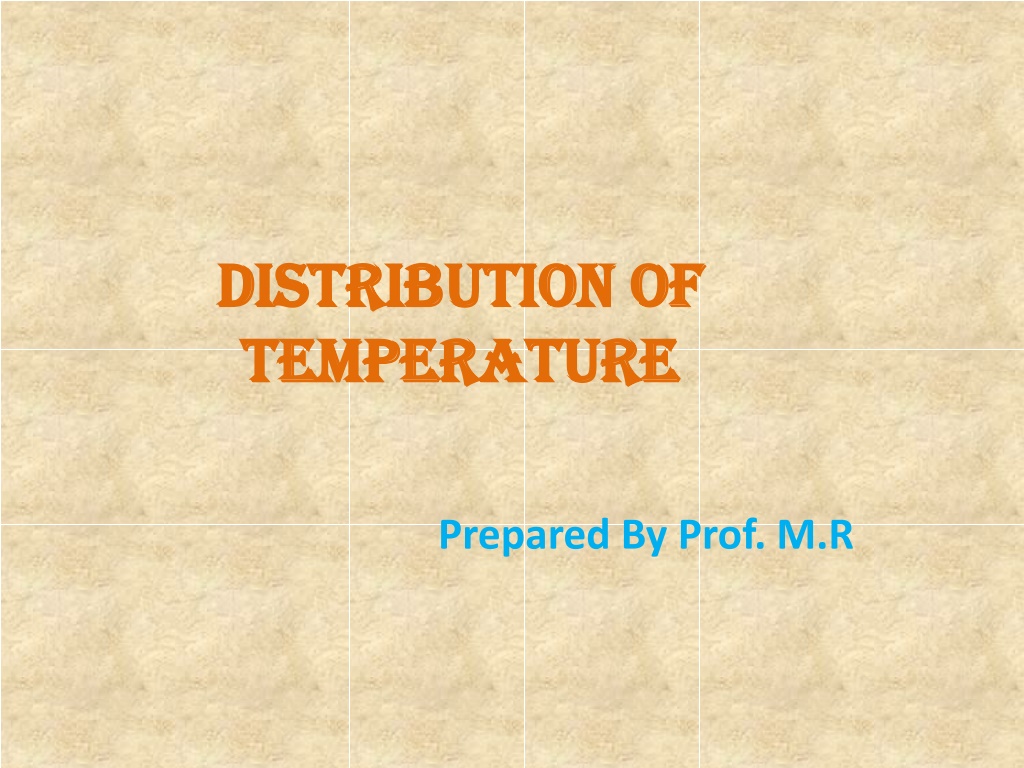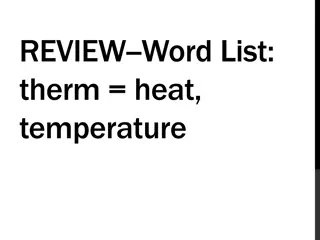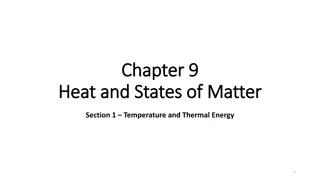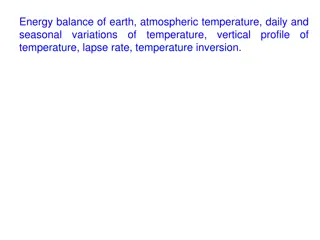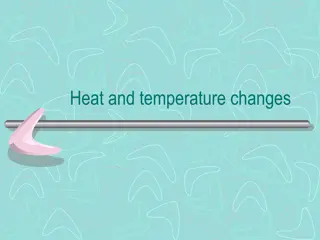Understanding Temperature Distribution and Differences in Heat
Explore the distribution of temperature across latitudes and elevations, and learn about the difference between heat and temperature. From horizontal to vertical variations, discover how factors like latitude influence temperature distribution patterns globally. Gain insights into the fundamental concepts of heat energy and temperature scales.
Download Presentation

Please find below an Image/Link to download the presentation.
The content on the website is provided AS IS for your information and personal use only. It may not be sold, licensed, or shared on other websites without obtaining consent from the author. Download presentation by click this link. If you encounter any issues during the download, it is possible that the publisher has removed the file from their server.
E N D
Presentation Transcript
Distribution Of Distribution Of Temperature Temperature Prepared By Prof. M.R
Difference between heat and Difference between heat and temperature temperature The interaction of incoming solar radiation (insolation) with the atmosphere and the earth s surface creates heat. This is measured in terms of temperature. While heat represents the molecular movement of particles comprising a substance, the temperature is the measurement in degrees of how hot (or cold) a thing (or a place) is. So, heat is the energy which makes things or objects hot, while temperature measures the intensity of heat (degree of hotness/coldness). Heat and temperature are closely related to each other because gain or loss of heat is necessary to raise or lower the temperature. The Celsius scale is the internationally accepted scale for reporting air temperature. Fahrenheit scale and Kelvin scales are other scales used to measure temperature. The Fahrenheit temperature scale is based on 32 F for the freezing point of water and 212 F for the boiling point of water, with the interval between the two being divided into 180 parts. On the Kelvin scale, 0 K represents absolute zero (-273 C), the temperature at which the molecules of a substance have their lowest possible energy.
Distribution of Temperature Distribution of temperature varies both horizontally and vertically. Let us study it under A) Horizontal Distribution of Temperature B) Vertical Distribution of Temperature
A) Horizontal Distribution of A) Horizontal Distribution of Temperature Temperature Distribution of temperature across the latitudes over the surface of the earth is called its horizontal distribution. On maps, the horizontal distribution of temperature is commonly shown by isotherms. Isotherms are line connecting points that have an equal temperature. When we analyse an isotherm map, it can be seen that the horizontal distribution of temperature is uneven.
Horizontal Distribution of Horizontal Distribution of Temperature Temperature
Controlling Factors for the uneven horizontal Controlling Factors for the uneven horizontal distribution of temperature distribution of temperature LATITUDE LATITUDE In the previous article, we have studied that the angle of incidence of sun s rays goes on decreasing from the equator towards the poles. Higher the angle of incidence, higher is the temperature. Similarly, lower the angle of incidence, lower is the temperature. This is why the temperature is higher near the tropical regions and decreases towards the poles.
Controlling Factors for the uneven horizontal Controlling Factors for the uneven horizontal distribution of temperature distribution of temperature ALTITUDE As we all know, the temperature in the troposphere goes on decreasing with increase in height. Temperature decreases at an average rate of nearly 6 degree Celsius per 1000 m altitude, which is known as Normal Lapse Rate.
Controlling Factors for the uneven Controlling Factors for the uneven horizontal distribution of temperature horizontal distribution of temperature Compared to land, the sea gets heated slowly and loses heat slowly. Land heats up and cools down quickly. As a result, the temperature is relatively higher on land during day time and it is higher in water during the night. Also, the places situated near the sea come under the moderating influence of the sea and land breezes which moderates the temperature. LAND AND SEA CONTRAST
Controlling Factors for the uneven Controlling Factors for the uneven horizontal distribution of temperature horizontal distribution of temperature There are also seasonal variations in the temperature of land and sea. During summer, the air above land has a higher temperature than the oceans. But the air above oceans gets higher temperature than landmass in winter. Notwithstanding the great contrast between land and water surfaces, there are differences in the rate of heating of different land surfaces. A snow-covered land as in polar areas warms very slowly because of a large amount of reflection of solar energy. A vegetation covered land does not get excessively heated because a great amount of insolation is used in evaporating water from the plants.
Controlling Factors for the uneven Controlling Factors for the uneven horizontal distribution of temperature horizontal distribution of temperature Ocean Currents are of two types warm and cold. Warm currents make the coasts along which they flow warmer, while cold currents reduce the temperature of the coasts along which they flow. The North-Western European Coasts do not freeze in winter due to the effect of North Atlantic Drift (a warm current), while the Quebec on the coast of Canada is frozen due to the Cold Labrador Current flowing along it, though the Quebec is situated in lower latitudes than the North-West European Coast.
Controlling Factors for the uneven horizontal Controlling Factors for the uneven horizontal distribution of temperature distribution of temperature Like the land and sea breezes, the passage of air masses also affects the temperature. The places, which come under the influence of warm air masses experience higher temperature and the places that come under the influence of cold air masses experience low temperature. AIR MASSES
Controlling Factors for the uneven horizontal Controlling Factors for the uneven horizontal distribution of temperature distribution of temperature VEGETATION COVER Soil devoid of vegetation cover receives heat more rapidly than the soil under vegetation cover. Because vegetation cover absorbs much of sun s heat and then prevents quick radiation from the earth whereas the former radiates it more rapidly. Hence the temperature variations in densely forested areas are lower than those in desert areas. Note: Along with these, the other factors which are responsible for the uneven horizontal distribution of temperature are winds, nature of the soil, slope and aspect of the surface, relief features, etc. The horizontal distribution of temperature over the globe can be studied easily from the isotherm maps of January and July months since the seasonal extremes of high and low temperature are most obvious in both northern and southern hemispheres during these months.
Horizontal Distribution of Temperature in Horizontal Distribution of Temperature in January January In January, the sun shines vertically overhead near the tropic of Capricorn. Hence, it is summer in southern hemisphere and winter in the northern hemisphere. A high temperature is found over the landmasses mainly in three regions of the southern hemisphere. These regions are North-West Argentina, East and Central Africa, and Central Australia. Isotherm of 30 C closes them.
Horizontal Distribution of Temperature in Horizontal Distribution of Temperature in January January
Horizontal Distribution of Horizontal Distribution of Temperature in July Temperature in July In July, the sun shines vertically overhead near the Tropic of cancer. Hence, high temperatures are found in the entire northern hemisphere. The regions having high temperature include South Western USA, the Sahara, the Arabia, Iraq, Iran, Afghanistan, desert region of India and China. However, the lowest temperature of 0 C is also noticed in the Northern Hemisphere during summer in the central part of Greenland.
Horizontal Distribution of Horizontal Distribution of Temperature in July Temperature in July
Horizontal Distribution of Horizontal Distribution of Temperature in July Temperature in July During summer in the northern hemisphere, isotherms bend towards the equator while crossing oceans and towards the poles while crossing landmasses. Isotherms are wide spaced over oceans while they are closely spaced over landmasses. In July, the deviation of isotherms is not that much pronounced as in January.
